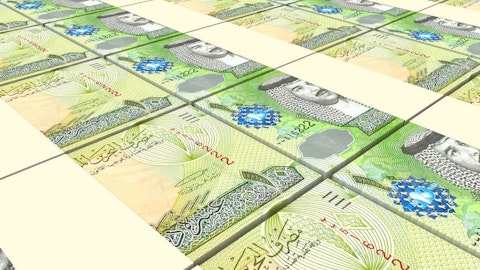Michael Chae: Thanks, Jon and good morning, everyone. The headline for the firm’s financial performance in the third quarter is stability amid a challenging external operating environment. Despite executing fewer sales in less favorable markets, we are generating a consistent and attractive baseline of earnings and dividends for shareholders. Meanwhile, we continue to expand the foundation of the firm’s earnings power across multiple drivers of growth. Starting with results. As Steve and Jon highlighted, the firm’s extraordinary breadth has supported continued growth in AUM despite the broader market declines. Total AUM increased 6% year-over-year, moving beyond the $1 trillion milestone, led by 10% growth in the credit and insurance sector.
The earning AUM rose 4% to a record $735 billion, driving base management fees up 6% to $1.6 billion, reflecting the 55th consecutive quarter of year-over-year base management fee growth at Blackstone. Fee related earnings were $1.1 billion in the third quarter or $0.92 per share, largely stable with Q2 underpinned by steady top line performance along with the firm’s strong margin position. A year-over-year comparison was affected by decline in transaction fees, which are activity based, as well as lower fee related performance revenues. Notwithstanding these headwinds, the firm generated $275 million of fee related performance revenues in the third quarter across multiple perpetual vehicles in real estate credit, notably reflecting the growing contribution from BCRED along with the material year-over-year increase from the BPP platform.
Distributable earnings were $1.2 billion in the third quarter or $0.94 per share, again stable with Q2. On a year-over-year basis, net realizations declined given the market backdrop. However, we did execute the sales of public stock in the London Stock Exchange Group and our stake in India based software company along with certain other holdings in private equity. Realizations also included a significant sale in BREIT, which as a reminder does not earn performance revenues based on individual asset sales, but on NAV subject to a hurdle. The sale was of a self-storage company for $2.2 billion, one of the largest ever transactions in the sector, which generated a profit of over $600 million and a gross multiple of invested capital of 1.8 times in less than three years.
BREIT’s asset sales since the beginning of last year when interest rates began moving materially higher have occurred at an average premium to their prior carrying value of 4%. Overall, we’ve been highly selective in terms of realizations and activity is likely to remain muted in the near-term given the environment. But the firm’s FRE continues to provide real ballast to earnings and Q3 represented the 8th consecutive quarter of FRE over $1 billion. Meanwhile, our long-term fund structures let us focus on building value in the portfolio while we wait for market conditions to improve. Performance revenue eligible AUM in the ground increased in the third quarter to a record $505 billion and has nearly doubled in the past three years. Net accrued performance revenue on the balance sheet, the firm’s store value stands at $6.4 billion or $5.29 per share.
We hold an expansive portfolio of exceptional quality and embedded value including $16 billion of public stock in our private equity and real estate drawdown funds. When markets ultimately become more receptive, we are well positioned for an acceleration in realization activity as well. Moving to the outlook, we remain highly confident in the multiyear expansion of the firm’s earning power and FRE with several embedded growth drivers. First, in our drawdown fund business, we’ve raised nearly 80% of our $150 billion target, but less than half was earning management fees at quarter end. We launched the investment period for the new European real estate flagship in September, which will earn management fees after an effective four months fee holiday for first closures.
Over the next several quarters subject to deployment, we expect to activate the new flagships; corporate private equity, private equity energy transition, growth equity and infrastructure secondaries followed by their respective fee holidays. Second, our platform of perpetual strategies has continued to expand including BCRED, which generates B related performance revenues quarterly based on investment income and our BIP infrastructure vehicle with its next crystallization scheduled to occur in the fourth quarter of 2024 with respect to three years of gains. Third, in the insurance area, AUM has reached $178 billion, as John noted, up 18% year-over-year, driven by robust inflows from our major clients from who we anticipate substantial largely contractual inflows in the years ahead.
In closing the firm’s all weather business model provides resiliency and staying power in difficult markets. Meanwhile, our underlying earnings power continues to build and we have greater investment firepower than ever before. With multiple growth engines driving us forward, we are well positioned for the future. With that, we thank you for joining the call. I would like to open it up now for questions.
Operator: Thank you. [Operator Instructions] We’ll go first to Glenn Schorr with Evercore ISI.
Glenn Schorr: Hi, good morning. I’ll try to simplify this because you just went through some of the building blocks for 2024 and beyond, but it feels like there has to be a little bit of reset down just because in this environment performance fees can only be so much. So maybe my key question is, if you’ve had good strong double digit FRE growth in the past, can we see double digit FRE growth in 2024 given the building blocks that you just ran through? And maybe a sidebar to that is, is can real estate and private equity work in a higher for longer rate backdrop, which we seem to be in? Thanks.
Michael Chae: So, Glenn, thank you for the question, it’s Michael. I’ll take on the first one, I think Jon will handle the second. Obviously at this point and especially for 2024, we’re not going to give granular guidance. I would say there are a number of key drivers that certainly inform our view over the long-term of sustained double digit FRE growth. In the near-term, I think it’s really important the point that I spent time on in my remarks which is the idea that management’s fee revenues which were stable quarter-over-quarter, really have an underlying ramp that based on activation of a number of these funds that will be a tailwind for our top line growth. And so as I said, $150 billion flagship fundraising cycles we’ve talked about nearly 80% raised and less than half, about 45% earning management fees as of the end of the quarter.
We expect that percentage to move up to a substantial majority of that total amount in the coming quarters by sort of the middle of next year, so that is a built-in thing. And the reason why we step back again why that that ramp has been somewhat slower than maybe was expected a couple years ago is because of market conditions and deployment, because basically in a lower deployment environment in the context of these markets, the investment periods last all else equal, longer for the predecessor funds and the launch of the new funds are delayed. So the money is substantially there from a fundraising standpoint. From a management fee earnings standpoint it will come on as these funds launch as is the after fee holidays as is the case with the European funds.
I think on fee related performance revenues, if you step back, I highlighted the credit fee related performance revenues, if you look and that’s in the segment financials, those were up in the credit segment 31% in the third quarter, 57% in the nine months year-to-date. So there’s real expansion going on there and as you know that earns incentive fees every quarter on the NAV base based on investment income which is very steady growing source of fees. And then BREIT we think is a portfolio well positioned and the BPP, we have scheduled crystallization in the fourth quarter. We have a meaningful amount next year and then we have a very significant, as I mentioned, scheduled crystallization on the infrastructure in the fourth quarter of next year.
That is a fund that’s appreciated 17% net historically and we’ll have another five quarters of gains built into one of the ultimate incentive fees late next year. So I would just give that as a framing for the underlying earnings power that we certainly see is very much intact long-term and in the near-term, and in next year there’s significant, I think underlying momentum.





